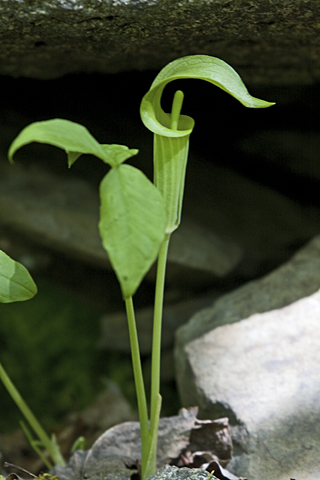Jack-in-the-Pulpit contains calcium oxalate crystals. These crystals are poisonous. When eaten, they stick in the mucous membranes of the mouth and cause burning, irritation, and swelling. The swelling can be severe enough to block a person's air passages.
On the other hand, the calcium oxalate crystals also give Jack-in-the-Pulpit its medicinal properties. Jack-in-the-Pulpit root tea has been used as an expectorant, diaphoretic (increases perspiration), and a purgative. The roots were well aged before being used to make the tea.
NATIVE AMERICAN USES: The Pawnee Indians ground the roots of this plant into a fine powder and dusted it onto the head and temples in order to cure headaches. Other Native Americans used it in the form of a poultice for rheumatism, boils, abscesses, and ringworm. The root was also dried, aged, and used to fight colds and coughs.
ANIMALS AFFECTED: All animals may be affected.
DANGEROUS PARTS OF PLANT: Bulbs, stems, possibly leaves.
CLASS OF SIGNS: Oral and gastric irritation, mouth and throat swelling on rare occasions may be severe enough to affect breathing.
SIGNS and FIRST AID: See the section for the Aroid discussion. Rarely is enough of this plant consumed to cause a problem, but the potential exists, especially in spring when other forages are not readily available and if the livestock have access to a wooded area. Signs are self-limiting, and a veterinarian only needs to be contacted if signs do not resolve or if breathing is affected.
PREVENTION: Jack-in-the-Pulpit grows in wooded, shaded areas in the spring, so limit animal access to these areas when plants begin to emerge.



